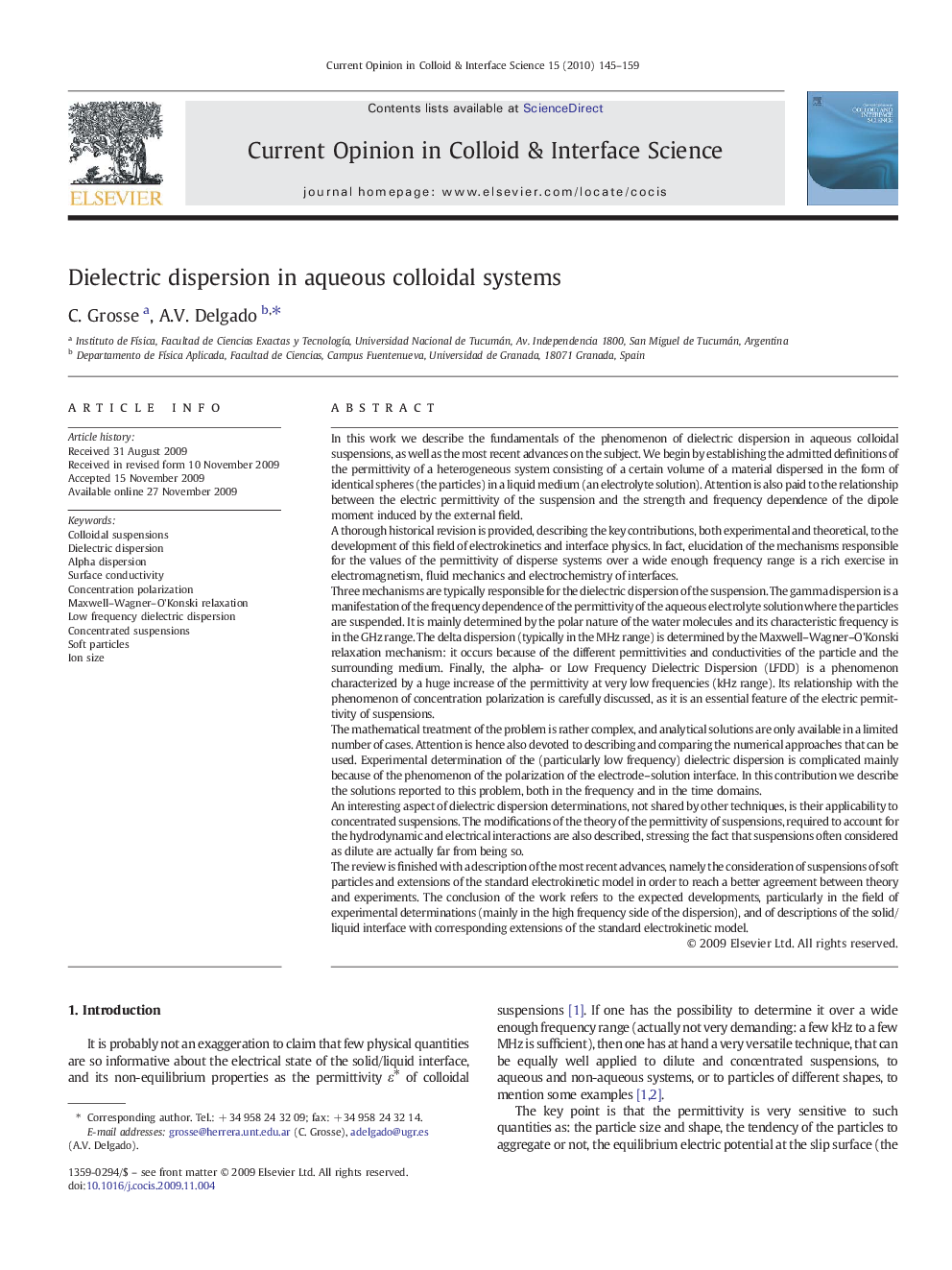| کد مقاله | کد نشریه | سال انتشار | مقاله انگلیسی | نسخه تمام متن |
|---|---|---|---|---|
| 603531 | 880240 | 2010 | 15 صفحه PDF | دانلود رایگان |

In this work we describe the fundamentals of the phenomenon of dielectric dispersion in aqueous colloidal suspensions, as well as the most recent advances on the subject. We begin by establishing the admitted definitions of the permittivity of a heterogeneous system consisting of a certain volume of a material dispersed in the form of identical spheres (the particles) in a liquid medium (an electrolyte solution). Attention is also paid to the relationship between the electric permittivity of the suspension and the strength and frequency dependence of the dipole moment induced by the external field.A thorough historical revision is provided, describing the key contributions, both experimental and theoretical, to the development of this field of electrokinetics and interface physics. In fact, elucidation of the mechanisms responsible for the values of the permittivity of disperse systems over a wide enough frequency range is a rich exercise in electromagnetism, fluid mechanics and electrochemistry of interfaces.Three mechanisms are typically responsible for the dielectric dispersion of the suspension. The gamma dispersion is a manifestation of the frequency dependence of the permittivity of the aqueous electrolyte solution where the particles are suspended. It is mainly determined by the polar nature of the water molecules and its characteristic frequency is in the GHz range. The delta dispersion (typically in the MHz range) is determined by the Maxwell–Wagner–O'Konski relaxation mechanism: it occurs because of the different permittivities and conductivities of the particle and the surrounding medium. Finally, the alpha- or Low Frequency Dielectric Dispersion (LFDD) is a phenomenon characterized by a huge increase of the permittivity at very low frequencies (kHz range). Its relationship with the phenomenon of concentration polarization is carefully discussed, as it is an essential feature of the electric permittivity of suspensions.The mathematical treatment of the problem is rather complex, and analytical solutions are only available in a limited number of cases. Attention is hence also devoted to describing and comparing the numerical approaches that can be used. Experimental determination of the (particularly low frequency) dielectric dispersion is complicated mainly because of the phenomenon of the polarization of the electrode–solution interface. In this contribution we describe the solutions reported to this problem, both in the frequency and in the time domains.An interesting aspect of dielectric dispersion determinations, not shared by other techniques, is their applicability to concentrated suspensions. The modifications of the theory of the permittivity of suspensions, required to account for the hydrodynamic and electrical interactions are also described, stressing the fact that suspensions often considered as dilute are actually far from being so.The review is finished with a description of the most recent advances, namely the consideration of suspensions of soft particles and extensions of the standard electrokinetic model in order to reach a better agreement between theory and experiments. The conclusion of the work refers to the expected developments, particularly in the field of experimental determinations (mainly in the high frequency side of the dispersion), and of descriptions of the solid/liquid interface with corresponding extensions of the standard electrokinetic model.
The real (a) and imaginary (b) components of the relative permittivity of suspensions of spherical particles are plotted as a function of frequency for different concentrations of solids (in percent volume fraction). Note that the amplitude of the dielectric relaxation goes through a maximum, whereas the alpha relaxation manifests at increasing frequencies, when the volume fraction is increased.Figure optionsDownload high-quality image (122 K)Download as PowerPoint slide
Journal: Current Opinion in Colloid & Interface Science - Volume 15, Issue 3, June 2010, Pages 145–159